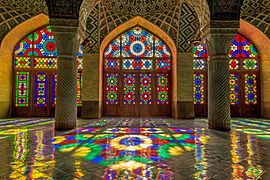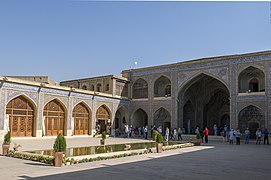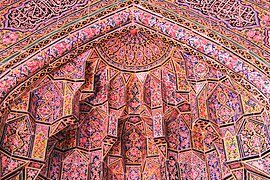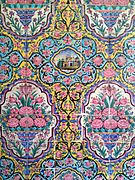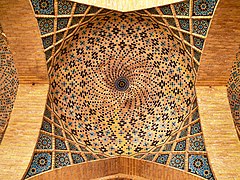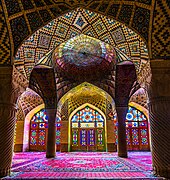|
Nasir-ol-Molk Mosque
The Nasir-ol-Molk Mosque (Persian: مسجد نصیرالملک, Masjed-e Nasir ol-Molk), also known as the Pink Mosque (مسجد صورتی, Masjed-e Surati), is a traditional mosque in Shiraz, Iran. It is located near Shāh Chérāgh Mosque. It was built during the Qajar era. The mosque includes extensive coloured glass in its facade, and displays other traditional elements such as the Panj Kāse ("five concaved") design.[1]  HistoryThe mosque was constructed between 1876 and 1888 and is still under use under the protection of the Endowment Foundation of Nasir-ol-Molk. It had been commissioned by Mirza Hasan Ali Nasir ol-Molk, one of the lords and aristocrats of Shiraz and the son of Ali Akbar Qavam ol-Molk the kalantar of Shiraz. The designers were Mohammad Hasan-e-Memār, a Persian architect who had also built the noted Eram Garden before the Nasir-ol-Molk Mosque, Mohammad Hosseini Shirazi, and Mohammad Rezā Kāshi-Sāz-e-Širāzi.[2] Orsi: Persian Stained Glass Although stained glass is mostly popular in churches nowadays, the earliest discovered was in Syria from the 7th century.[dubious – discuss] There is evidence of techniques and recipes for obtaining stained glass by the Persian chemist Jabir ibn Hayyan in his book Kitab al-Durra al-maknuna (The Book of the Hidden Pearl) published in the eighth century CE.[3] Orsi windows are windows made of a mixture of wood and colorful glass during the Safavid and Qajar eras. Orsi differs from stained glass used in many churches and Ottoman mosques which serve as illuminated images rather than a source of light. Light is a major feature in many mosques considering it being a major symbol of God in Islam. This is mentioned in a chapter of the Quran:
Gallery
  See alsoReferences
External linksWikimedia Commons has media related to Nasir-ol-Molk Mosque.
|
||||||||||||||||||||||||||||||||||||


